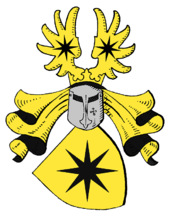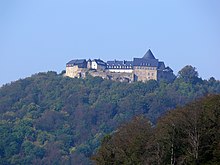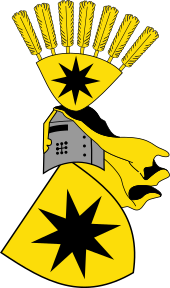Waldeck House




The Waldeck House is a German noble family . The Counts of Waldeck sprang from him , to whom the County of Pyrmont was also subordinate from the early 17th century . They had belonged to the hereditary princes since 1712 and ruled their state of Waldeck-Pyrmont, which had been united under constitutional law since 1848 and which is now in northern Hesse (in the Waldeck-Frankenberg district ) and south of Lower Saxony ( Hameln-Pyrmont district ) until their abdication in 1918 .
origin
The Waldeck House is the only still flourishing line of the medieval Counts of Schwalenberg with their ancestor Widekind I († 1136/37), who owned extensive territories in what is now the East Westphalia-Lippe region and the neighboring areas of Lower Saxony. Widekind's son Volkwin II. (1125–1177 / 78) married Luitgard, the daughter and heir of Count Poppo I von Reichenbach († 1156) , in the middle of the 12th century . So the Schwalenbergers came into the possession of Waldeck Castle , which is located in what is now northern Hesse , and the surrounding lands, which became the basis of the Waldeck territory that existed until the 20th century.
Volkwins II. Descendants, initially his sons, referred to themselves as Counts of Waldeck after this castle from 1180. Volkwin's youngest son Heinrich I (before 1178 – before 1214) was Count von Waldeck and Schwalenberg and bequeathed this title to his second son Volkwin IV. (Around 1190 – before 1255). Through his son Heinrich I von Schwalenberg († 1279), he became the founder of the Schwalenberg line of the Counts of Sternberg, which died out at the beginning of the 15th century . Previously, Volkwin IV. Had ceded his rights as Count von Waldeck to his younger brother Adolf I († 1270) in 1228 , who as a result of this division established the actual line of the Counts of Waldeck.
Since the death of Count Moritz von Pyrmont (around 1418–1494), the last direct male descendant of Volkwins II. Brother Wittekind II. Von Schwalenberg , the Waldeckers are the only remaining line of the former Schwalenbergs.
Lines
After the death of Count Heinrich VI. (around 1340–1397), a descendant of Adolf I in the fifth generation, this older Waldeck line split into two lines: the older Landau line with Adolf III. (1362–1431), who sat in Landau Castle and went out with the death of Otto IV (around 1440–1495), and the newer Waldecker line with Henry VII († after 1442), who even feuded with each other at times.
In 1486 the newer Waldecker line was divided into the older Waldeck-Wildungen line and the older Waldeck-Eisenberg line , which in 1495 also inherited the ownership of the older Landau line . Henry VIII (1465–1513) got Waldeck-Wildungen, his uncle Philip II (1453–1524) received Waldeck-Eisenberg. Already with the death of Philip III. (1486–1539) the Eisenberger split into a middle line Waldeck-Eisenberg , founded by his older son Wolrad II. (1509–1578), and a newer Landau line . The latter was donated by Wolrad's half-brother Johann I (1521 / 22–1567) and went away after a few decades with the death of his younger son Franz III. (1553–1597) again. The inheritance fell to the middle line Waldeck-Eisenberg and the older line Waldeck-Wildungen .
However, the latter died out the following year with the early death of Wilhelm Ernst (1584–1598), a fourth generation descendant of Henry VIII. The Wildunger possessions then also fell on the middle line Waldeck-Eisenberg , which promptly split again into two lines. The elder son of Josiah I. (1554-1588), Count Christian (1585-1637), it established the newer line Waldeck-Wildungen , while Christian's brother Wolrad IV. (1588-1640) the progenitor of the modern line of Waldeck-Eisenberg was . Philipp Dietrich (1614–1645), Wolrad IV's eldest son, inherited the county of Culemborg in Gelderland with the dominions of Werth in the Münsterland , Palant and Wittem through marriage in 1639 .
After the early death of Philipp Dietrich's son Heinrich Wolrad (1642–1664), Philipp Dietrich's brother Georg Friedrich (1620–1692) took over the inheritance, who was raised to the rank of imperial prince in 1682 by Emperor Leopold I (1640–1705) . After his four sons had all died before him, on June 12, 1685, by contract with Count Christian Ludwig (1635–1706) from the newer Wildunger line, he introduced the Primogenitur in the entire Waldeck house. Seven years later, after Georg Friedrich's death, with which the newer line Waldeck-Eisenberg became extinct, Christian Ludwig became the sole ruler of the entire county.
The county Cuylenburg and the rule Werth fell in 1714 as a result of the marriage of Georg Friedrich's second daughter Sophia Henriette (1662–1702) with Duke Ernst (1655–1715) in November 1680 to Saxe-Hildburghausen . In addition, the Waldecker inherited the Tonna rule in Thuringia in 1640 , which they sold to Duke Friedrich I of Saxe-Coburg-Altenburg (1646-1691) in 1677 .
As early as 1625, the Waldeck possessions included due to an inheritance contract that resulted from the marriage of Count Günther (1557–1585, from the older line of Waldeck-Wildungen) with Margarethe (1559–1580), an heir to the Counts of Gleichen Pyrmont county . The Waldeckers now owned, among other things, an old Schwalenberg territory.
The last significant division of the family took place in 1706: the newer Waldeck-Wildungen line went to the Waldeck-Pyrmont line , which became a princely line in 1712 when Friedrich Anton Ulrichs (1676–1728) was admitted to the hereditary imperial prince, and which continues to be the counts Waldeck-Bergheim line . The latter was founded by Friedrich Anton Ulrich's half-brother Josias I (1696–1763), had the rulership of Waldeck-Limpurg in Württemberg from 1816 to 1888 and expired in 1966 in the male line.
A division of the estate in 1805 was only effective for a short time: Prince Friedrich Karl August (1743–1812) ceded the county of Pyrmont to his brother Georg I (1747–1813) and was therefore limited to Waldeck, but died seven years later without heirs. Thereupon George I was able to reunite the principality of Waldeck with Pyrmont, which was also designated as a principality from 1807 (joining the Rhine Confederation ).
The Waldeck-Pyrmont line produced seven ruling princes. However, Emma zu Waldeck and Pyrmont (1858–1934), an older sister of the last prince , achieved the highest nobility position of all representatives of the house . She became Queen of the Netherlands and Grand Duchess of Luxembourg through marriage in 1879 . After the death of her husband Wilhelm III. (1817–1890) she represented their daughter Queen Wilhelmina (1880–1962) until she was of legal age in 1898 as regent of the Netherlands. Emma is thus the ancestral mother of all subsequent rulers from the House of Orange .
Illegitimate male descendants of Franz von Waldeck (1491–1553) lived until at least the beginning of the 20th century. The former princely main line of the Waldeck family, on the other hand, is still flourishing in the 21st century. The last Prince Friedrich (1865–1946), who abdicated in 1918, until 2012 had twelve offspring in the third generation and ten offspring in the fourth generation in the direct male line.
Since the death of the last Hereditary Prince Josias zu Waldeck and Pyrmont (1896–1967), Wittekind Prince zu Waldeck and Pyrmont (* 1936 in Arolsen ) has been the head of the Waldeck family in accordance with the guidelines of the German Nobility Law Committee . As such, he describes himself as Prince of Waldeck and Pyrmont , although since the abolition of the privileges of the nobility in 1919 only the title "Prince (-essin)" , but not the first-born title "Prince" , has been part of the civil name.
Personalities
Counts and Princes of Waldeck
Other important personalities
- Widukind von Waldeck († 1269), Bishop of Osnabrück
- Gottfried von Waldeck (* around 1255 / 60–1324), Bishop of Minden
- Dietrich von Waldeck (around 1316–1355), provost of the cathedral in the diocese of Münster
- Heinrich V. von Waldeck († after 1349), provost of the cathedral in Minden
- Franz von Waldeck (1491–1553), Bishop of Minden, Osnabrück and Münster
- Margaretha von Waldeck (1533–1554), possible historical model for the fairy tale figure Snow White
- Anna Erika von Waldeck (1551–1611), abbess of the imperial monastery in Gandersheim
- Bernhard von Waldeck (1561–1591), Bishop of Osnabrück
- Wolrad V. von Waldeck (1625–1657), Major General of Brandenburg
- Juliane Elisabeth von Waldeck (1637–1707), benefactress of the poor and orphans
- Amalia Katharina von Waldeck-Eisenberg (1640–1697), song poet of Pietism
- Christian August von Waldeck-Pyrmont (1744–1798), Austrian general and commander in chief of the Portuguese land army
- Hermann zu Waldeck and Pyrmont (1809–1876), Prussian lieutenant general
- Marie zu Waldeck and Pyrmont (1857–1882), first wife of the future King Wilhelm II of Württemberg
- Helene zu Waldeck and Pyrmont (1861–1922), member of the British royal family and mother of the last reigning Duke of Saxe-Coburg and Gotha
Tribe list
Family coat of arms
Blazon of the Waldeck family coat of arms : “An eight-pointed black star in gold . On the helmet with black and gold covers an open golden flight , each with a star . "
Blazon of the original coat of arms of the Waldeck family: “An eight-pointed black star in gold. On the helmet with black and gold covers, a shield-like umbrella board with seven golden feathers , inside the eight-pointed black star in gold. ”The open flight developed from the feather umbrella board .
residence
From 1180 the Waldeckers resided in the castle that gave their name to the castle or the Waldeck Castle that emerged from it, and since 1655 they have lived in the Arolsen Castle .
literature
- Johann Adolph Theodor Ludwig Varnhagen : Basis of the Waldeck country and regent history. Vandenhoeck & Ruprecht, Göttingen 1825–1853 ( Paderborn University Library ).
- Jakob Christoph Karl Hoffmeister: Historical-genealogical handbook about all counts and princes of Waldeck and Pyrmont since 1228. Klaunig, Cassel 1883 ( digitized version ).
- Carl Eduard Vehse: History of the German courts since the Reformation, p. 223ff. Section The count's branch lines Waldeck-Pyrmont, Bergheim and Waldeck-Pyrmont-Limpurg.



